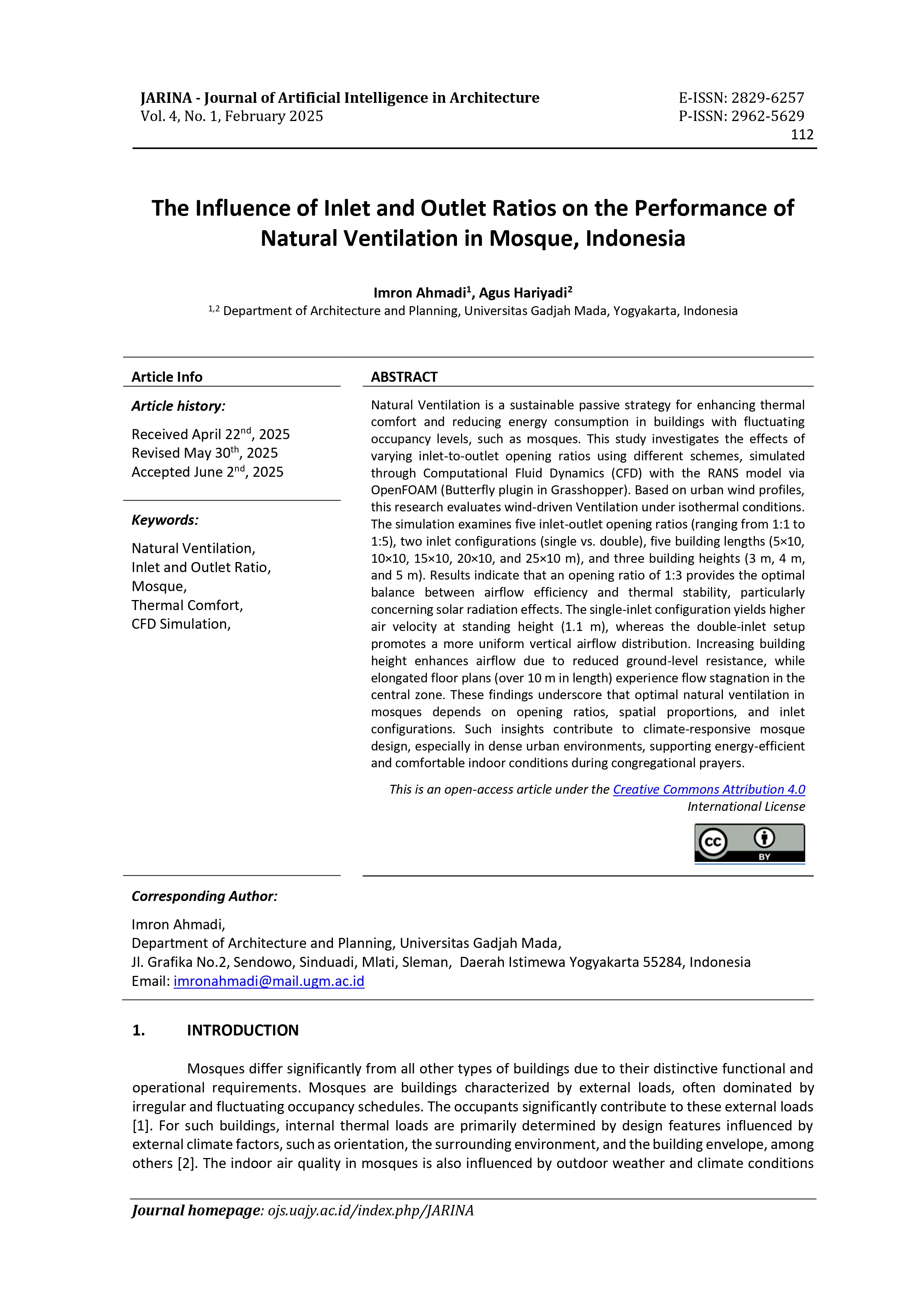The Influence of Inlet and Outlet Ratios on the Performance of Natural Ventilation in Mosque, Indonesia
DOI:
https://doi.org/10.24002/jarina.v4i2.11420Keywords:
Natural Ventilation, Inlet and Outlet Ratio, Mosque, Thermal Comfort, CFD SimulationAbstract
Natural Ventilation is a sustainable passive strategy for enhancing thermal comfort and reducing energy consumption in buildings with fluctuating occupancy levels, such as mosques. This study investigates the effects of varying inlet-to-outlet opening ratios using different schemes, simulated through Computational Fluid Dynamics (CFD) with the RANS model via OpenFOAM (Butterfly plugin in Grasshopper). Based on urban wind profiles, this research evaluates wind-driven Ventilation under isothermal conditions. The simulation examines five inlet-outlet opening ratios (ranging from 1:1 to 1:5), two inlet configurations (single vs. double), five building lengths (5×10, 10×10, 15×10, 20×10, and 25×10 m), and three building heights (3 m, 4 m, and 5 m). Results indicate that an opening ratio of 1:3 provides the optimal balance between airflow efficiency and thermal stability, particularly concerning solar radiation effects. The single-inlet configuration yields higher air velocity at standing height (1.1 m), whereas the double-inlet setup promotes a more uniform vertical airflow distribution. Increasing building height enhances airflow due to reduced ground-level resistance, while elongated floor plans (over 10 m in length) experience flow stagnation in the central zone. These findings underscore that optimal natural ventilation in mosques depends on opening ratios, spatial proportions, and inlet configurations. Such insights contribute to climate-responsive mosque design, especially in dense urban environments, supporting energy-efficient and comfortable indoor conditions during congregational prayers.
References
[1] N. A. Azmi, M. Arıcı, and A. Baharun, “A review on the factors influencing energy efficiency of mosque buildings,” J. Clean. Prod., vol. 292, p. 126010, Apr. 2021, doi: 10.1016/J.JCLEPRO.2021.126010.
[2] M. S. Al-Homoud, “Envelope thermal design optimization of buildings with intermittent occupancy,” J. Build. Phys., vol. 33, no. 1, pp. 65–82, 2009, doi: 10.1177/1744259109102799.
[3] A. B. Atmaca and G. Z. Gedik, “Determination of thermal comfort of religious buildings by measurement and survey methods: Examples of mosques in a temperate-humid climate,” J. Build. Eng., vol. 30, p. 101246, Jul. 2020, doi: 10.1016/J.JOBE.2020.101246.
[4] Q. Li, L. Zhang, L. Zhang, and X. Wu, “Optimizing energy efficiency and thermal comfort in building green retrofit,” Energy, vol. 237, p. 121509, Dec. 2021, doi: 10.1016/J.ENERGY.2021.121509.
[5] A. Yüksel, M. Arıcı, M. Krajčík, M. Civan, and H. Karabay, “Cooling operation strategies in a typical neighborhood mosque: A Case study on electricity consumption, CO2 emissions, and thermal comfort,” Energy Build., vol. 310, p. 114073, May 2024, doi: 10.1016/J.ENBUILD.2024.114073.
[6] A. Rahman, M. Qorib, and Z. Zuliana, “Pelatihan Tahsin Bacaan Sholat Dalam Meningkatkan Kualitas Bacaan Sholat Melalui Metode Muqotha’Ah Pada Ibu-Ibu Aisyiyah Ranting Puji Mulio,” JMM (Jurnal Masy. Mandiri), vol. 7, no. 6, p. 6158, 2023, doi: 10.31764/jmm.v7i6.17846.
[7] A. Yüksel, M. Arıcı, M. Krajčík, M. Civan, and H. Karabay, “Developing a strategy to reduce energy consumption and CO2 emissions from underfloor heating systems in mosques: A case study of a typical neighbourhood mosque,” Energy Build., vol. 287, p. 112984, May 2023, doi: 10.1016/J.ENBUILD.2023.112984.
[8] N. A. Azmi, A. Baharun, M. Arıcı, and S. H. Ibrahim, “C,” Front. Archit. Res., vol. 12, no. 2, pp. 361–385, Apr. 2023, doi: 10.1016/J.FOAR.2022.07.001.
[9] N. A. Azmi and S. H. Ibrahim, “A comprehensive review on thermal performance and envelope thermal design of mosque buildings,” Build. Environ., vol. 185, p. 107305, Nov. 2020, doi: 10.1016/J.BUILDENV.2020.107305.
[10] A. Sayed Hassan Abdallah, “Improved energy consumption and smart eco system for mosques in hot arid climates,” Ain Shams Eng. J., vol. 14, no. 7, p. 101997, Jul. 2023, doi: 10.1016/J.ASEJ.2022.101997.
[11] Q. Dong, S. Li, and C. Han, “Numerical and experimental study of the effect of solar radiation on thermal comfort in a radiant heating system,” J. Build. Eng., vol. 32, p. 101497, Nov. 2020, doi: 10.1016/J.JOBE.2020.101497.
[12] N. A. Azmi, A. Baharun, M. Arıcı, and S. H. Ibrahim, “Improving thermal comfort in mosques of hot-humid climates through passive and low-energy design strategies,” Front. Archit. Res., vol. 12, no. 2, pp. 361–385, Apr. 2023, doi: 10.1016/J.FOAR.2022.07.001.
[13] Y. Zhang, X. Zhou, Z. Zheng, M. O. Oladokun, and Z. Fang, “Experimental investigation into the effects of different metabolic rates of body movement on thermal comfort,” Build. Environ., vol. 168, p. 106489, Jan. 2020, doi: 10.1016/J.BUILDENV.2019.106489.
[14] A. ASHRAE, “ASHRAE Standard 55: Thermal environmental conditions for human occupancy,” Am. Soc. Heating, Refrig. Air-Conditioning Eng. Atlanta, GA, USA, 2017.
[15] M. Marzouk, M. El-Maraghy, A. El-Shihy, and M. Metawie, “Evaluating energy retrofit strategies in enhancing operational performance of mosques: A case study of Al-Imam Al-Hussein Mosque,” Clean. Energy Syst., vol. 9, p. 100144, Dec. 2024, doi: 10.1016/J.CLES.2024.100144.
[16] F. Ghaleb Noman, N. Kamsah, and H. Mohamed Kamar, “Jurnal Teknologi Full Paper IMPROVEMENT OF THERMAL COMFORT INSIDE A MOSQUE BUILDING,” vol. 78, pp. 2180–3722, 2016, [Online]. Available: www.jurnalteknologi.utm.my
[17] R. T. Novita, L. H. Sari, and A. Ariatsyah, “an Appraisal of Indoor Thermal Comfort in a Naturally-Ventilated Modified Old Mosque in Banda Aceh, Indonesia,” J. Islam. Archit., vol. 7, no. 3, pp. 364–370, 2023, doi: 10.18860/JIA.V7I3.17131.
[18] B. Song, L. Bai, and L. Yang, “Analysis of the long-term effects of solar radiation on the indoor thermal comfort in office buildings,” Energy, vol. 247, p. 123499, May 2022, doi: 10.1016/J.ENERGY.2022.123499.
[19] W. F. M. Yusoff, “The effects of various opening sizes and configurations to air flow dispersion and velocity in cross-ventilated building,” J. Teknol., vol. 82, no. 4, pp. 17–28, 2020, doi: 10.11113/jt.v82.14537.
[20] I. F. Ridzqo, E. Rochimah, and J. Soedarno, “Quantifying Window Effectiveness To Affect Wind Velocity By Experimental Study,” Sinergi, vol. 25, no. 2, p. 127, 2021, doi: 10.22441/sinergi.2021.2.003.
[21] W. Zhong, Y. Pan, W. Xiao, and T. Zhang, “Identifying bioclimatic techniques for sustainable low-rise high-density residential units: Comparative analysis on the ventilation performance of vernacular dwellings in China,” J. Build. Eng., vol. 80, p. 108008, Dec. 2023, doi: 10.1016/J.JOBE.2023.108008.
[22] Zai, “Evaluation of Various Turbulence Models in Predicting Airflow and Turbulence in Enclosed Environments by CFD: Part-1,” Ashrae, vol. 13, no. 6, pp. 1–26, 2012.
[23] X. Zhang, A. U. Weerasuriya, and K. T. Tse, “CFD simulation of natural ventilation of a generic building in various incident wind directions: Comparison of turbulence modelling, evaluation methods, and ventilation mechanisms,” Energy Build., vol. 229, p. 110516, Dec. 2020, doi: 10.1016/J.ENBUILD.2020.110516.
[24] N. Sakiyama, J. Frick, T. Bejat, and H. Garrecht, “Using CFD to Evaluate Natural Ventilation through a 3D Parametric Modeling Approach,” Energies, vol. 14, Apr. 2021, doi: 10.3390/en14082197.
[25] Y. Tominaga et al., “AIJ guidelines for practical applications of CFD to pedestrian wind environment around buildings,” J. Wind Eng. Ind. Aerodyn., vol. 96, no. 10–11, pp. 1749–1761, 2008, doi: 10.1016/j.jweia.2008.02.058.
[26] J. Franke, A. Hellsten, K. H. Schlünzen, and B. Carissimo, “The COST 732 Best Practice Guideline for CFD simulation of flows in the urban environment: A summary,” Int. J. Environ. Pollut., vol. 44, no. 1–4, pp. 419–427, 2011, doi: 10.1504/IJEP.2011.038443.
[27] R. Ramponi and B. Blocken, “CFD simulation of cross-ventilation for a generic isolated building: Impact of computational parameters,” Build. Environ., vol. 53, pp. 34–48, 2012.
[28] B. Blocken, T. Stathopoulos, and J. Carmeliet, “CFD simulation of the atmospheric boundary layer: wall function problems,” Atmos. Environ., vol. 41, no. 2, pp. 238–252, 2007.
[29] B. Blocken, J. Carmeliet, and T. Stathopoulos, “CFD evaluation of wind speed conditions in passages between parallel buildings—effect of wall-function roughness modifications for the atmospheric boundary layer flow,” J. Wind Eng. Ind. Aerodyn., vol. 95, no. 9–11, pp. 941–962, 2007.
[30] T. Cebeci, J. P. Shao, F. Kafyeke, and E. Laurendeau, “Computational fluid dynamics for engineers: from panel to Navier-Stokes methods with computer programs,” (No Title), 2005.
[31] Z. Zhang, Z. Wei, Z. Zhiqiang John, and Q. Y. and Chen, “Evaluation of Various Turbulence Models in Predicting Airflow and Turbulence in Enclosed Environments by CFD: Part 2—Comparison with Experimental Data from Literature,” HVAC&R Res., vol. 13, no. 6, pp. 871–886, Nov. 2007, doi: 10.1080/10789669.2007.10391460.
[32] T. G. Farea, D. R. Ossen, S. Alkaff, and H. Kotani, “CFD modeling for natural ventilation in a lightwell connected to outdoor through horizontal voids,” Energy Build., vol. 86, pp. 502–513, Jan. 2015, doi: 10.1016/J.ENBUILD.2014.10.030.
[33] S. V. Patankar and D. B. Spalding, “A calculation procedure for heat, mass and momentum transfer in three-dimensional parabolic flows,” Int. J. Heat Mass Transf., vol. 15, no. 10, pp. 1787–1806, Oct. 1972, doi: 10.1016/0017-9310(72)90054-3.
[34] H. K. Versteeg, An introduction to computational fluid dynamics the finite volume method, 2/E. Pearson Education India, 2007.
[35] R. F. Warming and R. M. Beam, “Upwind second-order difference schemes and applications in aerodynamic flows,” AIAA J., vol. 14, no. 9, pp. 1241–1249, 1976.
[36] H. Jasak, A. Jemcov, and Z. Tukovic, “OpenFOAM: A C++ library for complex physics simulations,” in International workshop on coupled methods in numerical dynamics, Dubrovnik, Croatia), 2007, pp. 1–20.
[37] F. M. L. M. M. Darwish, The finite volume method in computational fluid dynamics. 2016.
[38] J. H. Ferziger and M. Perić, Computational methods for fluid dynamics. Springer, 2002.
[39] G. Fang, M. Wei, L. Zhao, K. Xu, S. Cao, and Y. Ge, “Site- and building height-dependent design extreme wind speed vertical profile of tropical cyclone,” J. Build. Eng., vol. 62, p. 105322, Dec. 2022, doi: 10.1016/J.JOBE.2022.105322.
[40] ASHRAE-55, “Thermal Environmental Conditions for Human Occupancy-2017,” ANSI/ASHRAE Stand. 55, vol. 7, p. 60, 2017.
[41] H. Frick and C. Koesmartadi, Ilmu Fisika Bangunan, vol. 8. Kanisius, 2008.
[42] A. G. Safitra, L. Diana, J. Pratilastiarso, and N. Hidayat, “Numerical study the effect of inlet and outlet ventilation configurations for passive cooling air conditioning system,” 2024, doi: 10.31284/j.jmesi.2024.v4i2.6659.
[43] D. Maher et al., “Effect of inlet/outlet on thermal performance of naturally ventilated building,” Int. J. Low-Carbon Technol., vol. 16, no. 4, pp. 1348–1362, 2021, doi: 10.1093/ijlct/ctab055.
[44] S. Liu and C. Huang, “Optimization of natural ventilation of ‘yinzi’ dwellings in western hunan based on orthogonal experiment and CFD,” Buildings, vol. 6, no. 3, 2016, doi: 10.3390/buildings6030025.
[45] A. Kaushik, S. Singh, and M. Kapshe, “Changing vertical wind profile and its importance for wind-induced natural ventilation in high-rise buildings–a case of Pune,” J. Eng. Des. Technol., no. ahead-of-print, 2025.

Downloads
Published
How to Cite
Issue
Section
License
Copyright (c) 2025 Imron Ahmadi, Agus Hariyadi

This work is licensed under a Creative Commons Attribution 4.0 International License.
Authors who publish with this journal agree to the following terms:
1.Authors retain copyright and grant the journal right of first publication with the work simultaneously licensed under a Creative Commons that allows others to share the work with an acknowledgement of the work's authorship and initial publication in this journal.
2.Authors are able to enter into separate, additional contractual arrangements for the non-exclusive distribution of the journal's published version of the work (e.g., post it to an institutional repository or publish it in a book), with an acknowledgement of its initial publication in this journal.
3.Authors are permitted and encouraged to post their work online (e.g., in institutional repositories or on their website) prior to and during the submission process, as it can lead to productive exchanges, as well as earlier and greater citation of published work (See The Effect of Open Access).
















